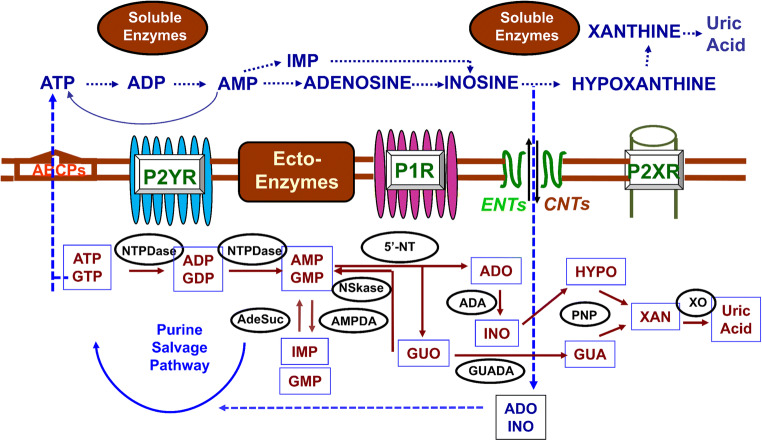Fig.2.
Synthesis, release, and metabolism of intra- and extra-cellular purines. Purine nucleotides are produced in cells by de novo synthesis and the salvage pathway, which recycles nucleosides and purine bases, also deriving from the turnover of nucleic acids, especially RNA [125]. Nucleotides (here, we consider mainly ATP) are released from virtually all cells in physiological conditions by different types of stimulation; additionally, cell damage and membrane leakage determine a huge purine increase in the extracellular fluid [127–129]. Besides secretory mechanisms typical of nervous cells, ATP release is mediated by connexin/pannexin hemichannels, facilitated diffusion by nucleotide-specific ATP-binding cassette transporters, and multiple organic anion transporters. Also, adenosine, in particular stress conditions, is released into the extracellular fluid by transporters; the principal function of which is, however, to bring adenosine back into the cells. The nucleoside transport system comprises equilibrative (ENTs) and concentrative transporters (CNTs) [131, 135] in mammalian cells. Thus, nucleosides are transported by ENTs in both directions depending on their concentration gradient across the plasma membrane, whereas the transport by CNTs is coupled to the concentration gradient of sodium ions. Finally, outside the cells, purines are catabolized thanks to the activity of membrane (ecto-enzymes) and soluble enzymes similar to those involved in the metabolism and salvage pathway of intracellular purines. Among the cell surface-expressed enzymes, the ecto-nucleotidase 1 (also known as CD39) efficiently hydrolyzes ATP to AMP, whereas the ecto-nucleotidases 2 or 3 and 8 lead to a sustained or transient ADP accumulation, respectively. Then, AMP produced from ATP and ADP degradation is further metabolized by ecto-5′-nucleotidase (also known as CD73) into adenosine. Finally, adenosine is inactivated via inosine into hypoxanthine by the tandem action of cell surface-located adenosine deaminase and purine nucleoside phosphorylase or, in part, is transported into the cell to replenish adenine nucleotide pool [132, 134]. Abbreviations: ABCPs, ATP-binding cassette proteins; ADA, adenosine deaminase; AdeSuc, adenyl-succinate synthase; HGPRT, hypoxanthine/guanine ribosyltransferase; NSkase, nucleoside kinase; NTPDase, Nucleotidase; 5-NT, 5’-nucleotidase; AMPDA, AMP deaminase; PNP, purine nucleoside phosphorylase; GUADA, guanine deaminase; XO, xanthine oxidase

